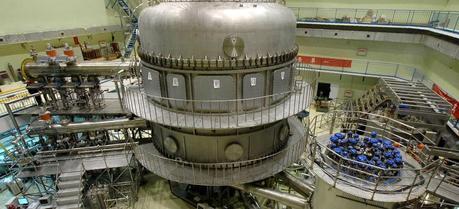 The Experimental Advanced Superconducting Tokamak (EAST) in Hefei, China. (Credit: ASIPP)
The Experimental Advanced Superconducting Tokamak (EAST) in Hefei, China. (Credit: ASIPP)
A multinational team led by Chinese researchers in collaboration with U.S. and European partners has successfully demonstrated a new method for suppressing instabilities that can cut short the life of controlled fusion reactions.
The team, headed by researchers at the Institute of Plasma Physics in the Chinese Academy of Sciences (ASIPP), combined the new technique with a method that the U.S. Department of Energy’s Princeton Plasma Physics Laboratory (PPPL) has developed for protecting the walls that surround the hot, charged plasma gas that fuels fusion reactions. A paper reporting the results was published in Nature Physics.
The record-setting results of the tests, conducted on the Experimental Advanced Superconducting Tokamak (EAST) in Hefei, China, could mark a key step in the worldwide effort to develop controlled fusion as a clean and abundant source of energy for generating electricity. “This is a very good example of multinational collaboration on EAST,” said ASIPP Director Jiangang Li. “I very much appreciate the effort of our collaborators.”
The findings could hold particular promise for developers of fusion facilities such as ITER, the international experiment under construction in France. Controlling instabilities that erupt at the edge of the plasma will be crucial to the success of the huge donut-shaped ITER tokamak, which is designed to demonstrate the feasibility of fusion power.
The EAST experiments set a record for the duration of what is called an H-mode, or high-confinement plasma—the type that ITER and other tokamaks will employ. To achieve this duration, the EAST team beamed into the plasma what are known as “lower hybrid wave current drive” microwaves. The antenna-launched beams reshaped the magnetic field lines confining the plasma and suppressed instabilities at the edge of the gas near the interior walls of the tokamak. Controlling these fast-growing instabilities, called “edge localized modes” (ELMs), produced a record life span of controlled fusion reaction of more than 30 seconds for the H-mode plasma.
These results suggested a potent new method for suppressing ELMS to create an extended, or long-pulse, plasma. Many methods already exist. Among them are the use of external magnetic coils to alter the field lines that enclose the plasma, and the injection of pellets of deuterium fuel into the plasma during experiments.
Contributing to the EAST results was the PPPL-designed wall treatment, which coated the plasma-facing walls of the tokamak with the metal lithium and inserted lithium granules into experiments to keep the coating fresh. The silvery metal absorbed stray plasma particles and kept impurities from entering the core of the plasma and halting fusion reactions. “When lithium has been used to coat the walls of fusion devices, higher plasma temperature, pressure and confinement have been achieved,” PPPL physicists Menard and Maingi said.
“This was good physics,” Jackson of General Atomics said of the experiments, noting that long-pulse plasmas will be required for fusion power plants to generate electricity.
Combining microwave beams for ELMs suppression with the advanced lithium wall treatment could thus provide a fruitful new direction for fusion-energy development. This combination of techniques, the Nature Physics paper said, offers “an attractive regime for high-performance, long-pulse operations.”
J. Li, H.Y. Guo, B.N. Wan, X.Z. Gong, Y.F. Liang, G.S. Xu, K.F. Gan, J.S. Hu, H.Q. Wang, L. Wang, L. Zeng, Y.P. Zhao, P. Denner, G.L. Jackson, A. Loarte, R. Maingi, J.E. Menard, M. Rack, X.L. Zou (2013). A long-pulse high-confinement plasma regime in the Experimental Advanced Superconducting Tokamak Nature Physics, 817-821 DOI: 10.1038/nphys2795
